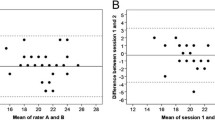Abstract
Purpose
Parkinson disease (PD) is one of the common causes of imbalance, and the balance assessment is necessary for treatment and rehabilitation of these patients. The Berg Balance Scale (BBS) has been the main instrument used to evaluate balance impairment. The purpose of this study is to investigate reliability and validity of the Persian translation of BBS in Parkinson disease.
Methods
One hundred PD patients (with mean age of 56.8 ± 15.13 years) were included. Interrater reliability was measured with the Kappa statistics and interclass correlation coefficients.
Results
The mean values of the BBS scored by the two evaluators were 47/85 ± 11/09 and 48/03 ± 10/90, respectively. The mean of Kappa coefficient between two examiners was 0.76, which was between 0.38 and 0.93 for various items. The total score recorded by both examiners, interclass correlation coefficient, was 0.99, which is excellent. Cronbach’s alpha for Iranian version of BBS was 0.92, which shows the excellent reliability of the questionnaire (0.62–0.9 for all items).
Conclusion
The Persian version of the BBS has excellent interrater reliability and internal consistency for the assessment of PD patients.

Similar content being viewed by others
References
Smania N, Corato E, Tinazzi M, Stanzani C, Fiaschi A, Girardi P, Gandolfi M (2010) Effect of balance training on postural instability in patients with idiopathic Parkinson’s disease. Neurorehabil Neural Repair 24:826–834
Tinetti ME (1986) Performance-oriented assessment of mobility problems in elderly patients. J Am Geriatr Soc 34:119–126
Berg KO, Wood-Dauphinee SL, Williams JI, Maki B (1991) Measuring balance in the elderly: validation of an instrument. Can J Public Health Rev 83:S7–S11
Berg KO, Maki BE, Williams JI, Holliday PJ, Wood-Dauphinee SL (1992) Clinical and laboratory measures of postural balance in an elderly population. Arch Phys Med Rehabil 73:1073–1080
Mao HF, Hsueh IP, Tang PF, Sheu CF, Hsieh CL (2002) Analysis and comparison of the psychometric properties of three balance measures for stroke patients. Stroke 33:1022–1027
Stevenson TJ (2001) Detecting change in patients with stroke using the Berg Balance Scale. Austr J Physiother 47:29–38
Wee JY, Wong H, Palepu A (2003) Validation of the Berg Balance Scale as a predictor of length of stay and discharge destination in stroke rehabilitation. Arch Phys Med Rehabil 84:731–735
Eftekharsadat B, Babaei-Ghazani A, Mohammadzadeh M, Talebi M, Eslamian F, Azari E (2015) Effect of virtual reality-based balance training in multiple sclerosis. Neurol Res 37:539–544
Zwick D, Rochelle A, Choksi A, Domowicz J (2000) Evaluation and treatment of balance in the elderly: a review of the efficacy of the Berg Balance Test and Tai Chi Quan. NeuroRehabilitation 15:49–56
Visser M, Marinus J, Bloem BR, Kisjes H, van den Berg BM, van Hilten JJ (2003) Clinical tests for the evaluation of postural instability in patients with Parkinson’s disease. Arch Phys Med Rehabil 84:1669–1674
Bloem BR, Lammers GJ, Overeem S, Grimbergen YA, Tetrud J (2000) Outcome assessment of retropulsion tests in Parkinson’s disease. Mov Disord 15(Suppl 3):179
Shephard RJ, Berridge M, Montelpare W (1990) On the generality of the “sit and reach” test: an analysis of flexibility data for an aging population. Res Q Exerc Sport 61:326–330
Eftekharsadat B, Babaei-Ghazani A, Habibzadeh A, Kolahi B (2015) Efficacy of action potential simulation and interferential therapy in the rehabilitation of patients with knee osteoarthritis. Ther Adv in Musculoskelet Dis 7:67–75
Mancini M, Horak FB (2010) The relevance of clinical balance assessment tools to differentiate balance deficits. Eur J Phys Rehabil Med 46:239
Thorbahn LDB, Newton RA (1996) Use of the Berg Balance Test to predict falls in elderly persons. Phys Ther 76:576–583
Qutubuddin AA, Pegg PO, Cifu DX, Brown R, McNamee S, Carne W (2005) Validating the Berg Balance Scale for patients with Parkinson’s disease: a key to rehabilitation evaluation. Arch Phys Med Rehabil 86:789–792
Franchignoni F, Velozo CA (2005) Use of the Berg Balance Scale in rehabilitation evaluation of patients with Parkinson’s disease. Arch Phys Med Rehabil 86:2225–2226
Scalzo PL, Nova IC, Perracini MR, Sacramento DR, Cardoso F, Ferraz HB, Teixeira AL (2009) Validation of the Brazilian version of the Berg Balance Scale for patients with Parkinson’s disease. Arq Neuropsiquiatr 67(3B):831–835
Salavati M, Negahban H, Mazaheri M, Soleimanifar M, Hadadi M, Sefiddashti L, Zahraee MH, Davatgaran K, Feizi A (2012) The Persian version of the Berg Balance Scale: inter and intra-rater reliability and construct validity in elderly adults. Disabil Rehabil 34:1695–1698
Azad A, Taghizadeh G, Khaneghini A (2011) Assessments of the reliability of the Iranian version of the Berg Balance Scale in patients with multiple sclerosis. Acta Neurol Taiwan 20:22–28
Acknowledgements
This study was financially supported by Iran University of Medical Sciences, Tehran, capital of Iran. We gratefully acknowledge the dedicated efforts of the investigators, the coordinators and the volunteer patients who participated in this study.
Author information
Authors and Affiliations
Corresponding author
Ethics declarations
Conflicts of interest
The authors have indicated that they have no conflicts of interests regarding the content of this article.
Statement of human and animal rights
All procedures performed in studies involving human participants were in accordance with the ethical standards of the institutional and/or national research committee and with the 1964 Helsinki declaration and its later amendments or comparable ethical standards.
Informed consent
Informed consent was obtained from all individual participants included in the study.
Rights and permissions
About this article
Cite this article
Babaei-Ghazani, A., Mohammadi, H., Shahidi, G.A. et al. Reliability and validity of the Persian translation of Berg Balance Scale in Parkinson disease. Aging Clin Exp Res 29, 857–862 (2017). https://doi.org/10.1007/s40520-016-0682-7
Received:
Accepted:
Published:
Issue Date:
DOI: https://doi.org/10.1007/s40520-016-0682-7




